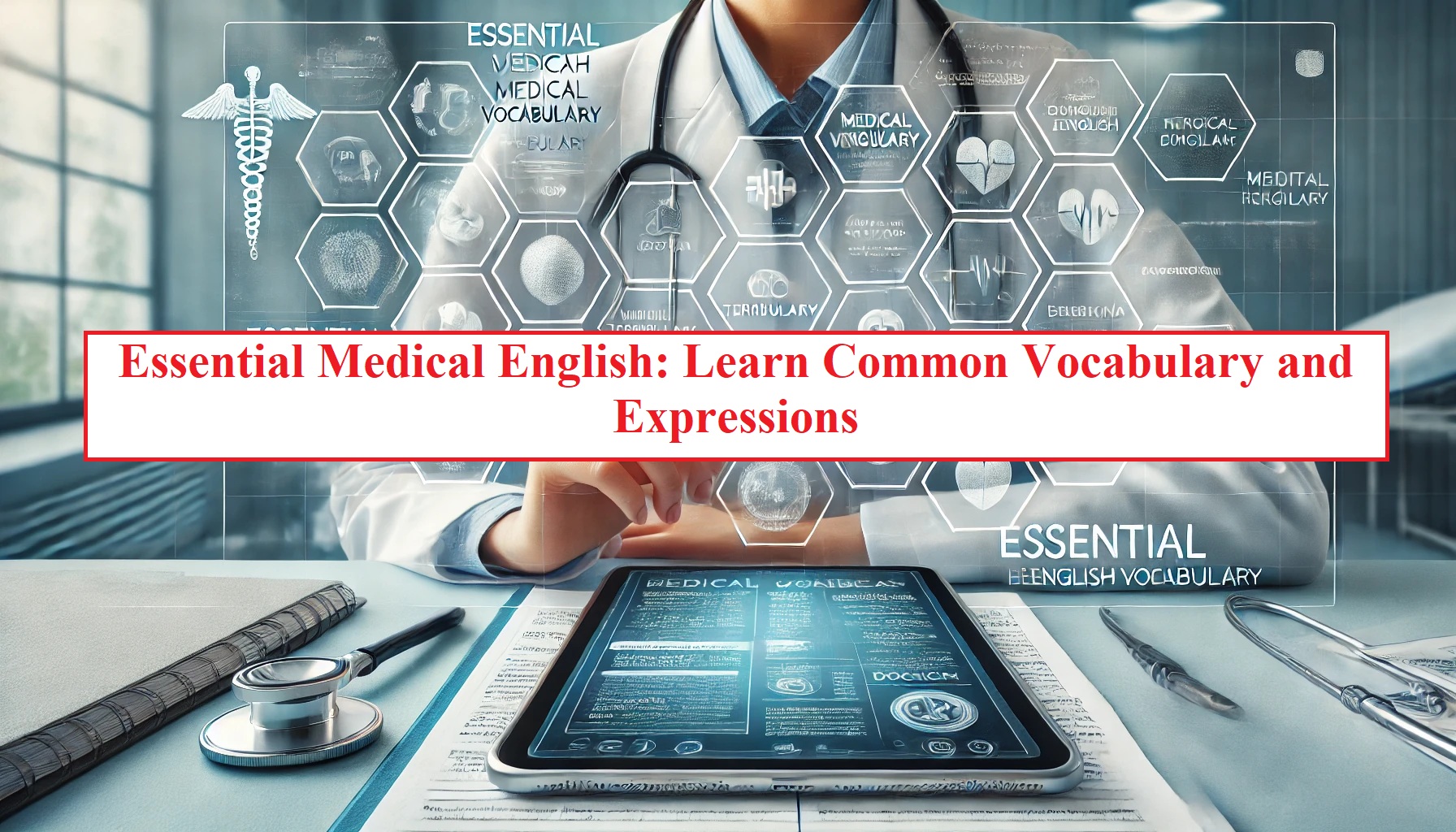انگلیسی در پزشکی و درمان: کلمات و اصطلاحات ضروری

در این مطلب، قصد داریم کلمات و اصطلاحات رایج و ضروری در محیط های درمانی و پزشکی را معرفی کنیم. استفاده دقیق از زبان در محیط های درمانی بسیار مهم است، برای همین پزشکان، پرستاران، و غیره باید کاربرد صحیح انگلیسی در پزشکی و درمان را یاد بگیرند.
کلمات و اصطلاحات پرکاربرد انگلیسی در پزشکی و درمان
ابتدا به سراغ فهرستی از کلمات ضروری انگلیسی در پزشکی و درمان میرویم و سپس اصطلاحات و جملات پرکاربرد را مرور می کنیم. برای هر مورد توضیح آن به زبان انگلیسی ارائه می شود تا کاربرد دقیق آن را بشناسید.
واژگان رایج و ضروری در پزشکی
1. Diagnosis (n.)
Definition: The process of identifying a disease or medical condition based on symptoms, tests, and examinations.
Example: The doctor made a diagnosis of pneumonia after reviewing the patient’s X-ray.
2. Symptom (n.)
Definition: A physical or mental feature that indicates the presence of a disease or condition.
Example: Fever and cough are common symptoms of the flu.
3. Prescription (n.)
Definition: A written order from a doctor that allows a patient to get a specific medicine from a pharmacy.
Example: The doctor gave me a prescription for antibiotics to treat the infection.
4. Treatment (n.)
Definition: Medical care given to a patient to cure or manage a disease or condition.
Example: The treatment for high blood pressure includes medication and lifestyle changes.
5. Surgery (n.)
Definition: A medical procedure that involves cutting into the body to repair or remove damaged tissues or organs.
Example: The patient needs surgery to remove the tumor.
6. Emergency (n.)
Definition: A serious and unexpected situation requiring immediate medical attention.
Example: He was taken to the emergency room after a severe allergic reaction.
7. Injection (n.)
Definition: The act of administering a drug or vaccine into the body using a syringe and needle.
Example: The nurse gave me a flu shot via injection.
8. Vaccine (n.)
Definition: A substance used to stimulate the body’s immune response against specific diseases.
Example: The COVID-19 vaccine has helped reduce severe illness worldwide.
9. Intravenous (IV) (adj.)
Definition: Refers to the administration of fluids or medication directly into a vein.
Example: The patient was given intravenous fluids to prevent dehydration.
10. Allergy (n.)
Definition: A condition in which the immune system reacts abnormally to a substance, such as pollen, food, or medication.
Example: She has a severe peanut allergy and carries an epinephrine auto-injector.
11. Prognosis (n.)
Definition: A forecast or prediction of the likely course and outcome of a disease.
Example: The prognosis for early-stage lung cancer is much better than for advanced cases.
12. Pathogenesis (n.)
Definition: The development and progression of a disease, including the biological mechanisms involved.
Example: Understanding the pathogenesis of Alzheimer’s disease is crucial for developing effective treatments.
13. Iatrogenic (adj.)
Definition: Refers to a disease or condition caused by medical treatment or intervention.
Example: The patient’s kidney damage was iatrogenic, resulting from prolonged use of certain medications.
14. Nosocomial Infection (n.)
Definition: An infection acquired in a hospital or healthcare setting.
Example: Strict hygiene protocols help prevent nosocomial infections in intensive care units.
15. Comorbidity (n.)
Definition: The presence of one or more additional diseases or disorders occurring with a primary disease.
Example: Diabetes and hypertension are common comorbidities in patients with heart disease.
16. Palliative Care (n.)
Definition: A type of medical care focused on relieving symptoms and improving the quality of life for patients with serious illnesses.
Example: Palliative care is essential for patients with advanced-stage cancer to manage pain and discomfort.
17. Hemodynamics (n.)
Definition: The study of blood flow and circulation within the cardiovascular system.
Example: The patient’s hemodynamic stability was closely monitored after surgery.
18. Anaphylaxis (n.)
Definition: A severe, potentially life-threatening allergic reaction.
Example: The patient experienced anaphylaxis after eating shellfish and required an immediate epinephrine injection.
19. Cytotoxic (adj.)
Definition: Refers to a substance that is toxic to cells, often used in chemotherapy to kill cancer cells.
Example: Cytotoxic drugs are commonly used in cancer treatment but may also damage healthy cells.
20. Idiopathic (adj.)
Definition: A condition or disease with no known cause.
Example: The patient was diagnosed with idiopathic pulmonary fibrosis, meaning its cause is unknown.
21. Metastasis (n.)
Definition: The spread of cancer cells from the original tumor to other parts of the body.
Example: The oncologist confirmed that the cancer had undergone metastasis to the liver.
22. Invasive Procedure (n.)
Definition: A medical procedure that involves entering the body, usually by cutting or inserting instruments.
Example: A biopsy is considered an invasive procedure used to diagnose abnormal tissue.
23. Homeostasis (n.)
Definition: The body’s ability to maintain a stable internal environment despite external changes.
Example: The kidneys play a crucial role in maintaining electrolyte homeostasis.
24. Myocardial Infarction (n.)
Definition: A medical term for a heart attack, caused by a blockage of blood flow to the heart muscle.
Example: The patient suffered a myocardial infarction due to a blocked coronary artery.
25. Neurodegenerative Disease (n.)
Definition: A condition characterized by progressive loss of nerve cell function, such as Alzheimer’s or Parkinson’s disease.
Example: Research into neurodegenerative diseases aims to slow down neuronal damage.
جملات و اصطلاحات رایج انگلیسی در پزشکی و درمان
1. “Take a deep breath.”
Meaning: A common instruction from doctors to patients, especially during physical examinations.
2. “Does it hurt when I press here?”
Meaning: A question asked by doctors to check for pain or tenderness in a specific area.
3. “You need to take this medication twice a day.”
Meaning: A typical instruction given when prescribing medicine.
4. “We need to run some tests.”
Meaning: The doctor needs to perform medical tests to diagnose a condition.
5. “Let me know if you feel any discomfort.”
Meaning: A way for healthcare professionals to check if a procedure is painful or uncomfortable for the patient.
6. “Stay hydrated and get plenty of rest.”
Meaning: Common advice given to patients with colds, flu, or minor illnesses.
7. “The condition is stable.”
Meaning: The patient’s health is not worsening or improving significantly at the moment.
8. “Follow up with me in a week.”
Meaning: The doctor wants to see the patient again after one week for further examination.
9. “You may experience some side effects.”
Meaning: A warning that a medication might cause minor health reactions.
10. “Call 911 in case of an emergency.”
Meaning: Standard advice in the U.S. for contacting emergency medical services.
11. “The patient is in critical but stable condition.”
Meaning: The patient’s health is serious but not worsening at the moment.
12. “We need to perform a differential diagnosis.”
Meaning: The doctor needs to compare multiple possible conditions to identify the correct one.
13. “This condition is refractory to treatment.”
Meaning: The disease is not responding to standard medical therapies.
14. “The scan reveals an abnormal mass in the thoracic cavity.”
Meaning: There is an unusual growth in the chest area that requires further investigation.
15. “The prognosis is poor, with a survival rate of less than 10% over five years.”
Meaning: The chances of recovery or survival are low.
16. “The patient exhibits signs of acute respiratory distress syndrome (ARDS).”
Meaning: The patient has a severe lung condition leading to breathing difficulties.
17. “We have ruled out infectious causes, suggesting the etiology is autoimmune.”
Meaning: The cause of the disease is likely related to the immune system rather than an infection.
18. “A multidisciplinary team will be involved in the patient’s care.”
Meaning: Different medical specialists will collaborate to treat the patient.
19. “The test results indicate an elevated white blood cell count, suggesting an inflammatory response.”
Meaning: The body is likely fighting an infection or inflammation.
20. “We need to monitor the patient’s vital signs closely for any signs of deterioration.”
Meaning: The doctor wants to track the patient’s heart rate, blood pressure, and breathing to check for worsening conditions.
این واژگان و اصطلاحات رایج انگلیسی در پزشکی و درمان برای زبانآموزانی که قصد دارند در محیطهای درمانی کار کنند، در رشته های مرتبط با پزشکی و کادر درمان تحصیل کنند، یا درک بهتری از متون علمی و گزارشهای پزشکی داشته باشند، بسیار مفید و ضروری هستند.
مطالب زیر نیز مفیدند:


